Services on Demand
Journal
Article
Indicators
-
 Cited by SciELO
Cited by SciELO -
 Access statistics
Access statistics
Related links
-
 Cited by Google
Cited by Google -
 Similars in
SciELO
Similars in
SciELO -
 Similars in Google
Similars in Google
Share
Universitas Psychologica
Print version ISSN 1657-9267
Univ. Psychol. vol.14 no.4 Bogotá Oct./Dec. 2015
https://doi.org/10.11144/Javeriana.upsy14-4.tscm
Towards a socio-community model: a well-being approach*
Hacia un modelo socio-comunitario: un enfoque de bienestar
Jorge Castellá Sarriera**
Lívia Maria Bedin
Universidade Federal do Rio Grande do Sul (UFRGS), Brasil
*Artículo de investigación. CAPES y al CNPq del Brasil por las ayudas recibidas con becas y con recursos para las investigaciones en las cuales se basa este artículo.
**Doctor en Psicología, profesor del Programa de Pós-grado en Psicologia de la UFRGS, investigador 1 A del CNPq y Coordinador del Grupo de Investigación en Psicología Comunitaria (GPPC). Doctora en Psicologia, pos-doctorado en la UFRGS, asesora en Análisis Multivariadas y SEM.
Enviado: 1° de marzo de 2015 | Revisado: 1° de junio de 2015 | Aceptado: 1° de agosto de 2015
Para citar este artículo:
Castellá, J., & Bedin, L. M. Towards a socio-community model: a well-being approach. Universitas Psychologica, 14(4), 1387-1398. http://dx.doi.org/10.11144/Javeriana.upsy14-4.tscm
Abstract
The objective of the present study is to develop a socio-community wellbeing model incorporating material resources, sense of community and environment satisfaction, and to verify the relation between the overall life satisfaction and the socio-community well-being model. Participants are 1157 children with ages from 10 to 13 years old, being 54.9% girls and 45.1% boys of five cities of the Rio Grande do Sul State (Brazil). The scales used were the Sense of Community Index (SCI), the Children's Environmental Attitudes Scale (CEAS), Material Resources and Overall Life Satisfaction (OLS) scale. Results show that all parameters in the model were statistically significant, that the well-being (OLS) has a significant and positive relationship with the proposed socio-community model indicating the validity of the measure and the construct have high factor weights for the socio-community well-being.
Keywords : socio-community model; well-being approach; community psychology; material resources; sense of community; environment satisfaction
Resumen
El presente trabajo busca desarrollar un modelo de bienestar sociocomunitario incorporando recursos materiales, sentimiento de pertenencia a la comunidad y satisfacción con el ambiente, y verificar la relación entre la satisfacción global con la vida y el modelo de bienestar sociocomunitario. Participaron 1157 niños de 10 a 13 años, siendo 54.9% niñas y 45.1% niños, de escuelas públicas y particulares de cinco ciudades del Estado del Rio Grande del Sur (Brasil). Las escalas utilizadas fueron: Sense of Community Index (SCI), Children's Environmental Attitudes Scale (CEAS), recursos materiales y Overall Life Satisfaction (OLS). Los resultados evidencian que todos los parámetros del modelo fueron estadísticamente significativos, que el bienestar (OLS) tiene una relación significativa y positiva con el modelo sociocomunitario propuesto indicando validez de la medida y el constructo presenta altos pesos factoriales para el bienestar sociocomunitario.
Palabras clave : modelo socio-comunitario; bienestar; psicología comunitaria; sentido de comunidad; recursos materiales; satisfacción con el ambiente.
The emphasis on the relevance of well-being studies and the current research of its different domains, strengthens those paradigms that analyze the phenomena in its complexity and attribute relevant role to the vital contexts and social and ecological dimensions that are currently considered essential for the study of human behavior. The Community Psychology, which has these assumptions in its bases, favors among its various theoretical approaches, the ecological model, emphasizing the subject-context interaction, so that its indissolubility and interdependence are part of the social and community phenomena (Sarriera, 2008).
In the field of Community Psychology, theoretical constructs that show the emphasis on the well-being of the communities have emerged in recent decades: Rapapport (1981) with the central concept of empowerment, Sarason (1974) with the psychological sense of community, and Montero (2004), who sustains that satisfaction with the community in its physical and psychological aspects is established in the place of preservation of individuality, as well as strengthening identity. The author also points out the importance of the study of community networks.
Other authors present paradigmatic advances, as Kelly (1986; 2006) with the ecological-contextual perspective in working with communities, and Wiesenfeld (1994) with the integrative proposal of the community environmental psychology. These studies show the degree of affinity and complementarity between the two areas, aiming to analyze the community-environment interaction that is capable to meet the needs of both and thus achieve the sustainable social well-being.
In terms of community development, current studies such as Neal and Neal (2014) have glimpsed possibilities of creating neighborhoods where, from fostering the sense of community among residents, the respect for diversity is stimulated. In Brazil, there is still a lack of studies regarding the importance of the psychological sense of community on children and community development.
Environmental characteristics influence subjective states, behaviors and feelings of belonging (Kuhnen & Silveira, 2008) and thus are relevant in addressing the social well-being. We have chosen three dimensions from the international project database of the Children's Worlds International Survey of Children's Well-Being to build our socio-community model: the assess of the material conditions of life, the sense of community and the variables related to the environment or vital context (Figure 1).
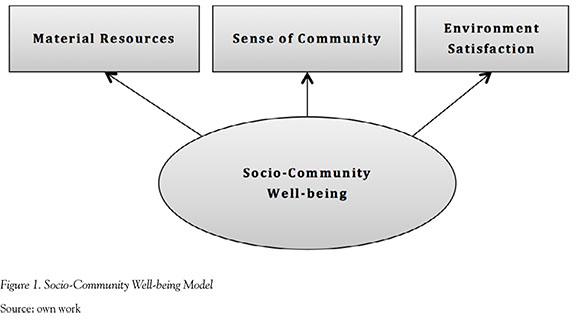
Each of these social and community dimensions is present in some form in theoretical constructs or concepts related to individual and collective wellbeing. In a recent study with 13,953 children aged from 10 to 14 years old (M = 12.05; SD = 0.59) from eight countries (Uganda, Algeria, South Africa, Israel, Brazil, South Korea, Spain and England), results indicated that the material resources are positively and significantly related to the subjective well-being for all countries, measured with the SLSS Huebner' scale (Sarriera, Casas, Bedin, Abs, Strelhow, Gross-Manos & Giger, 2014a). What calls attention in this study is that the countries with the largest relationship between access to material resources and well-being were Algeria, Uganda and South Africa, which are the countries that have lower frequencies of access to material resources. It is also noted that for children from countries with more access to resources, as in the case of South Korea, England and Spain, the relationship with the well-being is of smaller magnitude.
Convened by the international research proposal on subjective indicators of children and adolescents' well-being, with more than 15 countries from all continents, called "Children's Worlds" and with the previous experience of an international project (PROTEBA), together with Catalonia, Chile and Argentina, we expressed our interest in adding content that had relationship with the community well-being and material conditions, sense of security, sense of community, environment and well-being in the international research. We wonder what is the impact of these psychosocial and social variables on adolescents and children's well-being. These dimensions have been understudied, especially with children, and most studies are carried out with adult samples (Asadullah & Chaudhury, 2012; Clark, Frijters, & Shields, 2008; Cummins, 2000; Diener, Sandvik, Seidlitz, & Diener, 1993; Mayer & Frantz, 2004; Obst & White, 2004; Rojas, 2011). In this sense, by prioritizing childhood towards their well-being and quality of life, we pay special attention to a more vulnerable population.
Objective
Considering the mentioned above, the purpose of this study is: a) to develop a socio-community well-being model (SCWB) composed by the material resources access, the sense of community and the attitudes and satisfaction with the environment, and b) to verify if the subjective well-being perceived by children, measured by the overall life satisfaction single-item scale (OLS) is related to their SCWB.
Method
Participants
Participants were 1,157 children aged 10 to 13 years old (M = 10.99, SD = 1.01), of both sexes, being 54.9% girls and 45.1% boys, coming from public (66.2%) and private schools (33.8%) of the Rio Grande do Sul State. Considering location, 54.1% are located in the capital Porto Alegre and metropolitan area, and 45.9% in the inner cities of the State (Santa Cruz do Sul, Passo Fundo, Rio Grande and Santa Maria).
Instruments
Two independent translators fluent in English and in Brazilian Portuguese translated the scales used in the questionnaire. Then, two psychologists reviewed the conceptual equivalence of each item, by comparing with the original versions. After that, a bilingual expert back-translated de scales, and it was again compared with the originals in order to verify equivalence. For semantic validation, the scale was applied to 22 children who completed the instrument individually in order to assess possible difficulties in filling the questionnaire. Considering that children were able to understand the questionnaire, the final version was applied to the entire sample.
Sense of Community (SC): the Sense of Community Index (SCI ) (Sarriera et al., 2015) contains nine items covering two dimensions: a) Positive Bond with Community, and b) Community Neighbour's Relations. The items are answered on a 5-point scale, ranging from "Strongly disagree" to "Strongly agree". The scale was adapted from the one developed by Chavis, Hogge, McMillan, and Wandersman (1986). Regarding the psychometric properties of the SCS, Petersen (2009) found a Cronbach's alpha of 0.89 for the overall scale, and Sarriera et al. (2015) found a Cronbach's alpha of .78.
We have used two scales to measure children's Environment Satisfaction (ES). The first is the Children's Environmental Attitudes Scale (CEAS), which assesses children's commitment to protecting the environment using a 5-point scale (from 0 = never to 4 = always). The scale was adapted from the Children's Environmental Attitudes and Knowledge Scale (Leeming, Dwyer, Porter, & Bracker, 1995). For this study we used six items from the Attitude subscale. The Cronbach's alpha for the present sample is 0.75.
The second scale used is the Children's Environmental Satisfaction Scale (CESS). It was developed by the Research Group in Community Psychology and adapted from the Natural Relatedness Scale (NRS) (Nisbet, Zelenski, & Murphy, 2009), and from the study of Hur, Nasar and Chun (2010). The CESS measures the level of connection individuals have with the natural world and it is composed by six items covering two dimensions: a) Satisfaction with the Environment (a = 0.65 for the present sample), and b) Connectivity (a = 0.62 for the present sample). It is answered on a 5-point scale, ranging from "Strongly disagree" to "Strongly agree".
Material resources (MR): three items compose the material resources measure. The first item is formed by the sum of four questions measuring children's perceived access to: a computer, a mobile phone, the Internet, and clothes in good condition (e.g., "whether you have a computer") that were scored using a dichotomous response format (0 = no/1 = yes). In order to use these measures in the analysis, we created a variable called Material Resources Access by summing these four items and the new item ranges from 0 (no access to material resources) to four (full access to material resources). The second item measures the "satisfaction with all the things you have", ranging from 0 (completely unsatisfied) to 10 (completely satisfied) and the third item is formed by the question "I have what I want in life", using a 5-point scale (0 = strongly disagree to 4 = strongly agree).
Overall Life Satisfaction (OLS) is a single item scale measured with the question "Currently, to what extent are you satisfied with your life, considered globally?". Campbell, Converse and Rodgers (1976) reported the benefits of using a single item in the assessment of subjective well-being. The response ranges from 0 (completely dissatisfied) to 10 (completely satisfied).
Procedures
A one-stage cluster sampling design was used to select the sample. Data were collected in schools that were randomly selected from a list provided by the Education Department of the Rio Grande do Sul State and who authorized the research by signing the Institution Consent by the school director. We delivered the Consent Terms for students to take home and ask permission from their parents to participate in the research. Only children who provided a consent term signed by them and their parents or guardians participated in the study. The questionnaire was administered collectively in the classrooms of the participating schools and administered by two trained researchers. Children took approximately 50 minutes to complete the survey and the institution ethical committee approved the study.
Strategy of Analysis
First, to characterize the variables, data were first submitted to descriptive analysis. Frequency and means of the variables are reported. Then, we employed a confirmatory factor analysis (CFA) and a structural equation modeling (SEM), a statistical methodology based on the confirmation of hypotheses previously established by theoretical frameworks on the data. A structural equation model must meet general goodness-of-fit criteria to be considered adequate. This study uses Chi-square, the CFI (Comparative Fit Index), TLI (Tucker and Lewis Index) and the RMSEA (Root Mean Squared Error of Approximation) to assess model fit. We used the R 3.1.1 program to analyze data and we used the weighted least squares estimation (WLSMV) for the model, considering that the multivariate normality was not met for some measures used. Model fit was evaluated according the following criteria: CFI and TLI values above 0.95 and RMSEA values below 0.08, including confidence intervals (Batista-Foguet & Coenders 2000; Byrne 2010). Through CFA we developed a model to verify if the socio-community well-being (SCWB) model presents adequate fit indices and, through SEM, we verified if the SCWB model is related to the overall life satisfaction single-item scale (OLS).
Results
Characteristics of sociocommunity well-being items
The means and standard deviations of all items of the instruments used in the Socio-Community Well-being model are shown in Table 1. The Sense of Community item that presents the higher mean is "I feel at home in this neighborhood" and the one with lowest mean is "my neighbors and I want the same things".
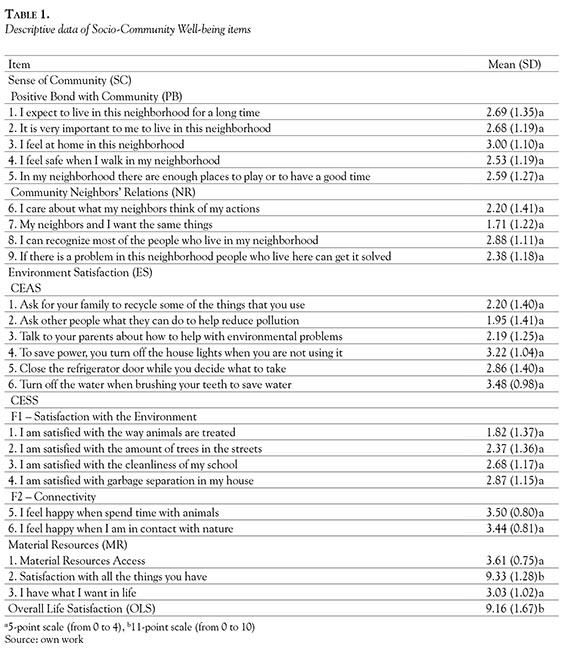
Regarding the Environment Satisfaction, the item with higher mean is "I feel happy when spend time with animals", and the one with lowest mean is "I am satisfied with the way animals are treated". As for the Material Resource factor, it is possible to see that the means are all high when considering the type of scale each item is assessed.
Confirmatory Factor Analysis (CFA)
First we conducted a confirmatory factor analysis to assess the model fit of each scale used in the SCWB model. Table 2 presents the fit indices for the scales used: a) Sense of Community Index (SCI) composed by two factors, b) Environment Satisfaction (ES) tested as a second-order factor and composed by the CEAS and the two factors of the CESS. The Material Resources (MR) is a one-dimensional factor, formed by three items with significant factor loadings. The fit indices for this measure are not presented because it is a just-identified model with zero degrees of freedom (saturated model).
It is observed that the models presented a CFI higher than .95 and the index of residues below .08. However, one item of the Sense of Community scale ("I can recognize most of the people who live in my neighborhood") did not present significant factor weight, so it was removed from the model, and only eight items of the SC scale was used. All other items presented significant factor loadings in the models.
Considering that these values are acceptable, we developed a third-order factor model for the Socio-Community Well-being (SCWB), joining the three constructs mentioned together. The CFA of the SCWB model showed adequate fit indices, as shown in Table 2.

Figure 2 shows the CFA SCWB Model obtained with the values of the standard parameters and the factor loadings. All parameters in the model were statistically significant (p < 0.05) as it can be observed in Table 3.
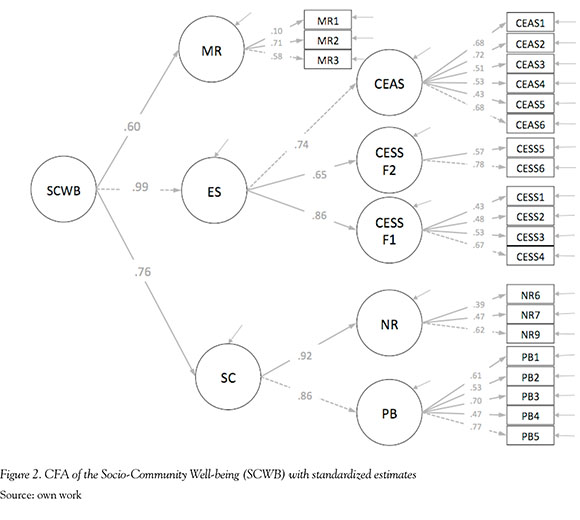
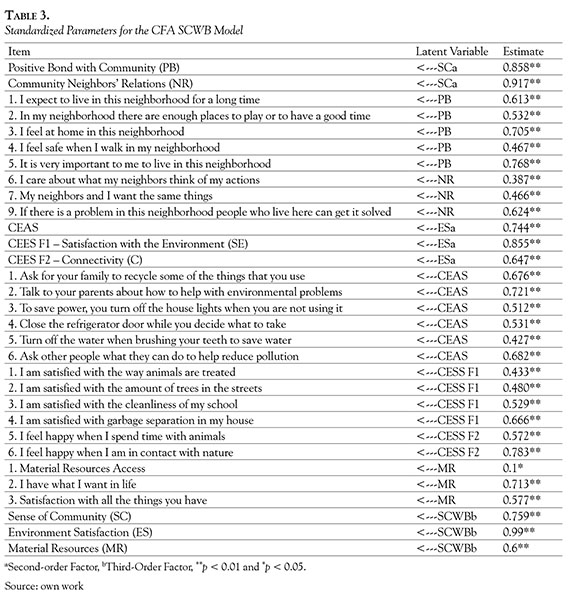
Structural Equation Modeling of the relationship between the SCWB model and children's overall life satisfaction (OLS)
The SEM model was developed to verify the relationship between the SCWB model and children's overall life satisfaction (OLS). Considering that it is a well-being measure we expected that they have significant relation among each other. Using the OLS as an observed item and the SCWB Model, the model presents adequate fit indices (%2 [244]= 577.47, p < 0.001, CFI = 0.972, TLI = 0.968, RMSEA = 0.034 [95% C.I. = 0.031-0.038]) and a significant relationship among the OLS and the SCWB presenting a weight of0.445 (p < 0.01). Figure 3 shows the path diagram of the model.
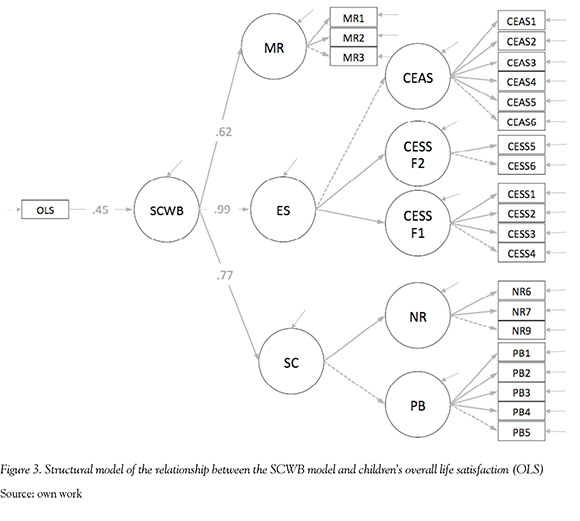
Main model results
-All parameters in the model were statistically significant (p < 0.05) (Table 3).
-The OLS have a significant and positive relationship with the SCWB model, indicating the measure's validity.
-The construct that presents the higher factor loadings for the SCWB is the environment satisfaction (0.99), followed by the sense of community (0.77) and the material resources (0.62). With these three dimensions, the SCWB construct could be explained by the OLS with a squared multiple correlation of 19.8%.
Discussion
In this study it was possible to develop a sociocommunity well-being model (SCWB) composed by three dimensions: the material resources access, the sense of community and the attitudes and satisfaction with the environment of children, reaching a model with satisfactory fit indices and with all parameters statistically significant. It was also possible to verify a significant and positive relationship between the SCWB model and the well-being measured by the overall life satisfaction single-item scale (OLS), indicating the measure's convergent validity.
The results on material resources support the findings of previous research (Sarriera et al. 2014a), considering that the impact of access to resources in well-being is higher in children living in countries with less access to resources, especially in cases of children living in condition of important material resources' deprivation. In the current study, the material resources treated together with the sense of community and environment, continues to have a significant weight on the well-being model, now measured and related to the OLS.
Regarding the sense of community and wellbeing, our results reinforce the research of Amaro (2007), since their items on sense of community are related to higher well-being levels, greater life satisfaction, as well as lower levels of loneliness and isolation. Also the results of Elvas and Moniz (2010) points out that the feeling of belonging to a community is related to greater protection and security, greater concern for the community, more collaboration among people, as well as lower rates of suicide and decrease of criminality.
In the environment-context dimension, which is the dimension with higher weight in the SCWB, the results corroborate the findings of Goswa-mi (2012), being the relations with friends in the neighborhood predictors of subjective well-being, followed by family relationships. Importantly, the increase in well-being works as a protective factor for children, helping in coping with adverse situations so common in Latin American community contexts (Oros, 2009).
The results also support the findings about the importance of the surroundings of children's residence place, the places to play (Rogers, 2012) and the presence of other children in the neighborhood (McAuley, McKeown, & Merriman, 2012; Rogers, 2012) helping the well-being with safe, quiet, calm and clean places perceived positively by the children as they allow play in the streets and physical activities (Homel & Burns, 1987). The presence of environmental attitudes, talk to family members about environmental issues, school cleaning and satisfaction with nature and animals contact were some of the well-being predictors found (Sarriera et al., 2014b).
We can conclude that the importance of material resources, the positive sense of community and the satisfaction with the environment are the guarantee of the possibilities for better levels of sociocommunity well-being. This study has limitations, one is the fact that the measures used to develop the socio-community well-being model are still being tested, so the improvement of these measures might be necessary, specially regarding the material resources variables. Other limitation is the fact of using only quantitative methodology in understanding a psychosocial phenomenon that could be deepened with supplemental qualitative methodology. Future studies could verify if similar results are found with participants in other stages of development, whether prior or subsequent to adolescence or even with adolescents from other countries, checking if the proposed model could have good fit indices considering different cultures and contexts.
References
Amaro, J. P. (2007). Sentimento psicológico de comunidade: Uma revisão. Análise Psicológica, XXV(l), 25-33. [ Links ]
Asadullah, M. N., & Chaudhury, N. (2012). Subjective well-being and relative poverty in rural Bangladesh. Journal of Economic Psychology, 33, 940-950. [ Links ]
Batista-Foguet, J. M., & Coenders, G. (2000). Modelos de ecuaciones estructurales. Madrid: La Muralla. [ Links ]
Byrne, B. M. (2010). Structural equation modeling with AMOS. Basic concepts, applications and programming (2nd Ed.). New York: Routledge. [ Links ]
Campbell, A., Converse, P. E., & Rodgers, W. L. (1976). The quality of American life: perceptions, evaluations and satisfactions. New York: Russel Sage Foundation. [ Links ]
Chavis, D. M., Hogge, J. H., McMillan, D. W., & Wan-dersman, A. (1986). Sense of community through Brunswik's lens: A first look. Journal of Community Psychology, 14(1), 24-40. [ Links ]
Clark, A., Frijters, P., & Shields, M. (2008). Relative income, happiness, and utility: An explanation for the Easterlin paradox and other puzzles. Journal of Economic Literature, 46(1), 95-144. [ Links ]
Cummins, R. A. (2000). Personal income and subjective well-being: A review. Social Indicators Research, 52, 55-72 [ Links ]
Diener, E., Sandvik, E., Seidlitz, L., & Diener, M. (1993). The relationship between income and subjective wellbeing: Relative or absolute? Social Indicators Research, 28, 195-223. [ Links ]
Elvas, S., & Moniz, M. (2010). Sentimento de comunidade, qualidade e satisfação de vida. Análise Psicológica, 3(XXVIII), 451-464. [ Links ]
Goswami, H. (2012). Social relationships and children's subjective well-being. Social Indicators Research, 107(3), 575-586. [ Links ]
Homel, R., & Burns, A. (1987). Is this a good place to grow up in? Neighbourhood quality and children's evaluations. Landscape and Urban Planning, 14, 101-116. [ Links ]
Hur, M., Nasar, J., & Chun, B. (2010). Neighborhood satisfaction, physical and perceived naturalness and openness. Journal of Environmental Psychology, 30(1), 52-59. doi: http://dx.doi.org/10.1016/j.jenvp.2009.05.005 [ Links ]
Kelly, J. G. (1986). Context and process: an ecological view of the interdependence of practice and research. American Journal of Community Psychology, 14(6), 581-589. doi: http://dx.doi.org/10.1007/BF00931335 [ Links ]
Kelly, J. G. (2006). Becoming ecological: an expedition into community psychology. New York: Oxford Press. [ Links ]
Kuhnen, A., & Silveira, S. M. (2008). Como as crianças percebem, idealizam e realizam o lugar onde moram. Psicologia USP, 19(3), 295-316. [ Links ]
Leeming, F., Dwyer, W., Porter, B., & Bracker, B. (1995). Children's environmental attitudes and knowledge scale: Construction and validation. Journal of Environmental Education, 26, 22-31. doi: http://dx.doi.org/10.1080/00958964.1995.9941442 [ Links ]
Mayer, F. S., & Frantz, C. M. (2004). The connectedness to nature scale: a measure of individuals' feeling in community with nature. Journal of Environmental Psychology, 24, 503-515. doi: http://dx.doi.org/10.1016/j.jenvp.2004.10.001 [ Links ]
McAuley, C., McKeown, C., & Merriman, B. (2012). Spending time with Family and Friends: Children's Views on Relationships and Shared Activities. Child Indicators Research, 5(3), 449-467. [ Links ]
Montero, M. (2004). Introducción a la psicología comunitária: Desarrollo, conceptos y procesos. Buenos Aires: Paidós. [ Links ]
Neal, Z. P., & Neal, J. W. (2014). The (in)compatibility of diversity and sense of community. American Journal of Community Psychology, 53, 1-12. doi: http://dx.doi.org/10.1007/s10464-013-9608-0 [ Links ]
Nisbet, E., Zelenski, J., & Murphy, S. (2009). The nature relatedness scale: Linking individuals' connection with nature, environmental concern, and behavior. Environment and Behavior, 41, 715-740. doi: http://dx.doi.org/10.1177/0013916508318748 [ Links ]
Obst, P. L., & White, K. M. (2004). Revisiting the sense of community index: A confirmatory factor analysis. Journal of Community Psychology, 32(6), 691-705. doi: http://dx.doi.org/10.1002/jcop.20027 [ Links ]
Oros, L. (2009). El valor adaptativo de las emociones positivas. Una mirada al funcionamiento psicológico de los niños pobres. Revista Interamericana de Psicología, 43(2), 288-296. [ Links ]
Petersen, S. A. (2009). Sense of community in a primary school learning community Unpublished master's thesis. Massey University, Palmerston North, New Zealand. [ Links ]
Rappaport, J. (1981) In praise of paradox. A social policy of empowerment over prevention. American of Community Psychology, 9(1), 1-26. [ Links ]
Rogers, M. (2012). They are there for you: the importance of neighborhoods friends to children wellbeing. Childrens Indicators Research, 5, 483-502. [ Links ]
Rojas, M. (2011). Poverty and psychological distress in Latin America. Journal of Economic Psychology, 32, 206-217. [ Links ]
Sarason, S. B. (1974). The psychological sense of community: Prospects for a community psychology. San Francisco: Jossey-Bass. [ Links ]
Sarriera, J. C. (2008). El paradigma ecológico en la psicologia comunitaria: del contexto a la complejidad. En Saforcada, E. & Sarriera, J. C. (Eds.). Enfoques conceptuales y técnicos en psicología comunitaria (pp. 27-49). Buenos Aires: Paidós. [ Links ]
Sarriera, J. C., Casas, F., Bedin, L., Abs, D., Strelhow, M. R., Gross-Manos, B., Giger, J. (2014a). Material Resources and children subjective well-being in eight countries. Child Indicators Research, 8(1), 199-209. doi: http://dx.doi.org/10.1007/s12187-014-9284-0 [ Links ]
Sarriera, J. C., Schütz, F. F., Galli, F., Bedin, L., Strelhow, M. R. W., Calza, T. Z. (2014b). Informe de pesquisa: bem-estar na infância e fatores psicossociais associados. Porto Alegre: Editora Concórdia. [ Links ]
Sarriera, J. C., Strelhow, M. R. W., Bedin, L. M., Moura, J. F. Jr., Rodrigues, A. L., Calza, T. Z. (2015). Sense of Community Index for Children. Ribeirao Preto: Paidéia. [ Links ]
Wiesenfeld, E. (1994). La Psicología Ambiental en el contexto de la comunidad: hacia una psicología ambiental comunitaria. Psicología Contemporánea, 1(2), 40-49. [ Links ]














